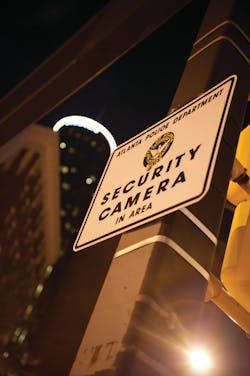The swift and successful investigation of the terrorist attack during the Boston Marathon shined a bright light on the value of both public and private-sector video when shared with police.
It is common knowledge that police regularly ask public organizations, businesses and individuals to share video that might help in the investigation of a crime; however, in recent years, police requests for video have grown into formal programs.
Police departments in Philadelphia, Elgin, Ill., San Ramon, Calif., and Ventura, Calif., for example, all have programs that ask organizations and individuals to register their surveillance cameras. The involved department then maps the cameras and consults a detailed map of nearby cameras when a crime is committed. Some cities —Atlantic City and Atlanta, for instance — have automated the process and can tap into cameras online from their communication centers.
Registering and Mapping Cameras in Ventura
Through its Video Camera Community Partnership Program, the Ventura Police Department asks businesses and residents to register security cameras that record activity in public areas. “We enter the address, the number of cameras and the direction they are facing into CAD (Computer Aided Dispatch),” says Commander Tim Turner, Field Operations, with the Ventura Police Department. “We also estimate the size of the area the camera or cameras can cover.”
When a call comes in, the CAD system scans the registered cameras, Turner explains. If the system finds cameras that cover the location of the call, a flag with an address pops up on the screen in the vehicle of the responding officer, who will then contact the owners of the cameras by phone, e-mail or in person.
For less serious crimes, officers ask the camera owners to review the video before and after the time the call came in and to let them know about anything that might be useful. If there is useful video, the officer asks for or makes a DVD copy to retain as evidence. “For serious crimes like murder, we will review the video immediately and make a copy if it has evidentiary value,” Turner says.
Video that is incompatible with the police department’s system is not much of a problem. “We have a multiplexer here that reads different video formats,” Turner says. “If the multiplexer can’t read a video format, we’ll go back to the owner and watch the video there and record from the screen. In some cases, we might ask our High Tech Task Force to reformat the video for our system.”
The Ventura Police Department has also knitted together a network of city-owned cameras watching areas of the city as well as cameras from middle schools and high schools. The school installations include exterior cameras and interior cameras in the lobbies and large common areas, such as cafeterias and gymnasiums. The system was not designed to intrude — it was designed to help police in the event of a dangerous emergency such as an active shooter.
Video from city and school cameras feeds into the transportation center in the police station where it can be monitored. The system includes cameras from several manufacturers. To view it at the police monitoring station, something has to convert it. For that, the police use a VidSys Physical Security Information Management (PSIM) system that integrates security devices and operational data into a single system. “We have interfaces written between the system and all of the different cameras,” Turner says.
Casinos that Share
In Atlantic City, 13 casinos started sharing video surveillance and communication systems with the police last year, even though each casino’s systems differ greatly from the others. An interoperability technology from Mutualink ties everything together. “There were 13 different video systems, 13 different radio systems and 13 different telephone systems,” explains Robert Wright, CPP, Mutualink’s business development director. “Our technology bridges each casino’s systems to make them available to the police.”
In the event of an emergency at one of the casinos, police can call up the casino’s video surveillance system and talk on the radio with casino employees from police landlines or cell phones. Employees that are off site can use their cell phones to call in and reach other employees over the radio. Once on site, police can use their radios to talk to casino employees who are using casino radios.
That’s a lot of sharing. “There are some concerns about big brother watching,” Wright concedes. “But the casinos will only share when they want to. Casino employees must set the Mutualink technology to allow sharing before the police can get into the system. Casino employees can turn it off any time they want.”
Now that the casinos are online, Atlantic City plans to expand the Mutualink network to other private entities.
Atlanta’s Goal: Link 14,000 Cameras
In years past, Atlanta police would go to businesses near the scene of an incident and ask for video. All too often, the video quality wasn’t good enough or the cameras were inoperable. Today, the city is integrating public and private camera feeds — often from updated systems — into a single center. The goal is to tie 14,000 cameras together over the next five years.
The Operation Shield Video Integration Center, as it is called, has currently garnered feeds from nearly 1,700 cameras from private organizations, public entities and the City of Atlanta. The Center has been open for 18 months.
The private sector in Atlanta is stepping up to build out the system. “We’re getting access to private businesses and large corporations,” says Grant M. Hawkins, MPA, vice president of Programs & Strategic Projects with the Atlanta Police Foundation. “They are investing in infrastructure, and this is saving the city the cost of adding more of its own cameras. Often the companies upgrade their system so that we can have access. I think this is a good model for a public-private partnership for video sharing.”
To tie the disparate camera systems together, the Center uses PSIM software from CNL Software called IPSecurityCenter, which can connect and manage disparate building and security technologies such as video, fire and life safety systems, HVAC GPS tracking and others. “The PSIM enables us to pull in different camera and system types,” Hawkins says. “It can pull up anything — alarms, locators, tag readers. It enables us to integrate all of our siloed systems, including the computer-aided dispatch system.
“We can tap into the cameras during an incident,” Hawkins continues. “Officers will use the video to understand the situation before they arrive. Once on the scene, video can help them mitigate the situation. After the incident, the video becomes an investigative tool.”
Once the cameras are in, the project will begin to integrate what Hawkins calls live crime data with the video. Once the data is added in, here’s an example of how it will work:
When a “shot-fired” call comes in to 911, the operator will push a button to send a code designating the call to the Video Integration Center. Officers are dispatched, and as they start on their way, officers in the Center have called up video feeds from the four nearest cameras and can tell officers about the scene. In addition, officers in the Center will call up the now live crime data for that location to provide perspective. The data might reveal that there have been 10 shooting incidents at the location over the past two years. The trouble usually involves a drug deal gone wrong. Most of these incidents have only involved two people.
The system enables officers to understand the situation at the scene before they arrive and whether or not it is the same kind of event that historically happens at this location. In the end, these kinds of shared video systems will make the police more effective as well as safer while engaged in the most situations on the job.
Geoffrey T. Craighead, CPP, is vice president of Universal Protection Service and the current president of ASIS International. With more than 30 years experience, he is an expert in security operations and crisis management for corporate campus and commercial high-rise facilities. ASIS International’s 59th Annual Seminar and Exhibits (ASIS 2013) is Sept. 24-27 at McCormick Place in Chicago. Attendees will take away new information, insights, and the knowledge needed to mitigate risk and secure people, property, and information. Once again, the (ISC)2 Security Congress will co-locate with the ASIS event. For more information, visit www.asis2013.org.



